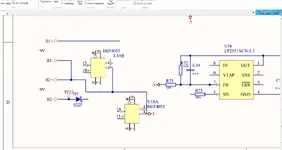AugustMoose87
Sr. Member
- Joined
- Sep 10, 2014
- Messages
- 443
- Reaction score
- 264
- Golden Thread
- 0
- Location
- Longmont, CO
- Detector(s) used
- Gold Pan, Sluice, Hand Dredge, X-Terra 30, X-Terra 705, Sand Shark
- Primary Interest:
- All Treasure Hunting
- #1
Thread Owner
So I've used my Titan 1000XD less than a week, and I'm already wondering about a mod... The batteries died on me today, and as I'm sure more experienced detectorist are all too well aware, 9v batteries are  expensive... So I'm sitting there thinking about the fact that the clad I've found so far will just barely cover the cost of 2 9v batteries, when I think "I've got a few rechargeable 18v... huh, I wonder if those are in parallel or series..." So I grab the electrical tester, and test for connectivity, and they are in series, meaning the detector runs of 18v. I happen to have 4-5 rechargeable 18v batteries for my cordless tools... Anybody ever try this?? I'm thinking of mounting the battery on a belt or something, since that would probably double the weight of the unit. And then just run cables to the unit.
expensive... So I'm sitting there thinking about the fact that the clad I've found so far will just barely cover the cost of 2 9v batteries, when I think "I've got a few rechargeable 18v... huh, I wonder if those are in parallel or series..." So I grab the electrical tester, and test for connectivity, and they are in series, meaning the detector runs of 18v. I happen to have 4-5 rechargeable 18v batteries for my cordless tools... Anybody ever try this?? I'm thinking of mounting the battery on a belt or something, since that would probably double the weight of the unit. And then just run cables to the unit.
I realize that this would be over-doing it, since those batteries have 2.4 amp hours compared to around 0.5 in the 9volts, but I thinking it would have a number of advantages for me... Cost of 9v, rechargeable, already own multiple batteries, I even have a car charger for those batteries... And I would have to run some tests, but I'm fairly certain based on how long the 9v's lasted that one pack would last more than a day... So hypothetically speaking, I could detect from dawn to dusk, throw the battery on a charger and have it ready before I get to sleep (they take 1 hour to charge).
The only downsides I see are more weight and having a "tether" running along my arm. Or who knows, I may see if I can find a spot to attach it on the detector where it balances well...
Thoughts?
 expensive... So I'm sitting there thinking about the fact that the clad I've found so far will just barely cover the cost of 2 9v batteries, when I think "I've got a few rechargeable 18v... huh, I wonder if those are in parallel or series..." So I grab the electrical tester, and test for connectivity, and they are in series, meaning the detector runs of 18v. I happen to have 4-5 rechargeable 18v batteries for my cordless tools... Anybody ever try this?? I'm thinking of mounting the battery on a belt or something, since that would probably double the weight of the unit. And then just run cables to the unit.
expensive... So I'm sitting there thinking about the fact that the clad I've found so far will just barely cover the cost of 2 9v batteries, when I think "I've got a few rechargeable 18v... huh, I wonder if those are in parallel or series..." So I grab the electrical tester, and test for connectivity, and they are in series, meaning the detector runs of 18v. I happen to have 4-5 rechargeable 18v batteries for my cordless tools... Anybody ever try this?? I'm thinking of mounting the battery on a belt or something, since that would probably double the weight of the unit. And then just run cables to the unit. I realize that this would be over-doing it, since those batteries have 2.4 amp hours compared to around 0.5 in the 9volts, but I thinking it would have a number of advantages for me... Cost of 9v, rechargeable, already own multiple batteries, I even have a car charger for those batteries... And I would have to run some tests, but I'm fairly certain based on how long the 9v's lasted that one pack would last more than a day... So hypothetically speaking, I could detect from dawn to dusk, throw the battery on a charger and have it ready before I get to sleep (they take 1 hour to charge).
The only downsides I see are more weight and having a "tether" running along my arm. Or who knows, I may see if I can find a spot to attach it on the detector where it balances well...
Thoughts?






 Unfortunately its difficult to obtain schematics or diagrams. Then one has to know how to interpret them to use them effectively. With training or just self study reverse engineering is the only way to go to discover how a system is structured. However there are certain basic principles that should be followed when attempting to modify an unknown system~ research is one key and basic electrical knowledge another. Never assume
Unfortunately its difficult to obtain schematics or diagrams. Then one has to know how to interpret them to use them effectively. With training or just self study reverse engineering is the only way to go to discover how a system is structured. However there are certain basic principles that should be followed when attempting to modify an unknown system~ research is one key and basic electrical knowledge another. Never assume 